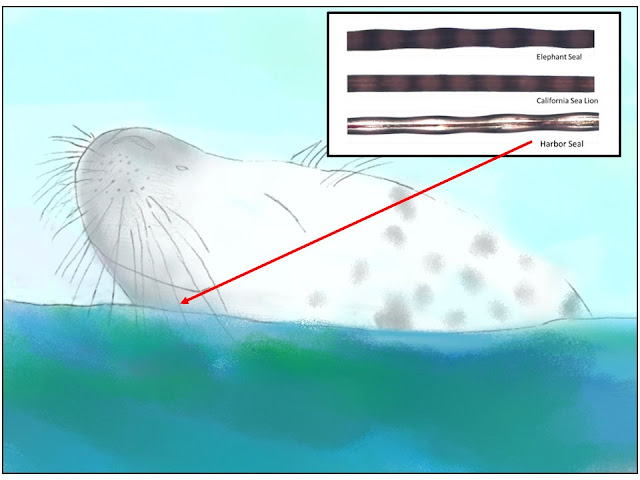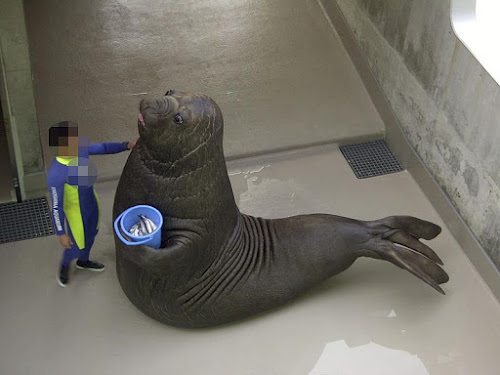Harbor Seal Whisker Science
Have you ever wondered how Seals can locate their fibsh ("fish" in Pinniped speak - see the video of Egg for educational content on the language of Pinnipeds)? So have many researchers!
My drawing of Harbor Seal, with close-up pictures of different Pinniped whiskers
What sense do Seals use to hunt fibsh? I am not sure how they use sight, taste, or smell to hunt fibsh, and this is something that I would like to find out more about later in another post. After doing some research on this topic, I was surprised that they used touch by feeling vibrations in the water through their whiskers (called vibrissae). When fibsh swim underwater, they create vorticies, which are disruptions in the water that fibsh make when they swim. See the figure below.
Fibsh leaving disturbances in the water as it swims.
From the Doctoral Dissertation by Heather Rachel Seem, 2015. Passive Wake Detection Using Seal Whisker-Inspired Sensing. Ph.D. Thesis. MIT/WHOI, 2015-03. This looks like an interesting paper with a lot of references, and has this cutely educational picture of a seal hunting fibsh using whiskers.
In order to figure out of if Seals can sense fibsh disturbances, many different researchers have conducted experiments with blindfolded and ear muffed Seals to see how well they could catch fibsh "blind" and "deaf." See below for an example of the experimental setup.
Harbor Sea blindfolded and ear muffed, ready to find fibsh
From article "Seal Whiskers Can Detect Weak Water Currents"
Experiments have found that Seals primarily use their whiskers to find fibsh, and are able to follow the disturbances that the fibsh leave in the water for quite a long distance. For example, there was an experiment where researchers used a miniature submarine to simulate a fibsh swimming through the water. The researchers would have the robot "fibsh" swim a path unknown to the Seal. Then, they asked the Seal to find the "fibsh" while he was still blindfolded and after the "fibsh" motor was shut off and not making noise. As you can see from the photo below, the Seal (red arrows, when you can't clearly see the Seal) wouldn't swim straight towards the robot "fibsh" (yellow arrows or line) but would follow the wake disruptions in the water.
Harbor Sea follows the wake (path) of the robot fish, instead of heading towards the robot fibsh as it would if it used sight and hearing
However, when the Seal had their whiskers covered, they could not detect the "fibsh" because they could not sense the wake disturbance. This is good evidence that Seals use their whiskers to find fibsh by following the wake of the fibsh. In the first photo of this post, you can also see whiskers of other Pinnipeds. Why they look different is a good question, which I want to look into at a later time.
The researchers also did another experiment where they allowed the Seal to listen for the robot "fibsh." When the Seals could listen, they swam right for the robot "fibsh" and did not follow its path left by the wake.
To me, this means that Seals use their whiskers to track and catch fibsh. Unless it is a really loud fibsh, then they would use their hearing to track and catch the fibsh.







Comments
Post a Comment